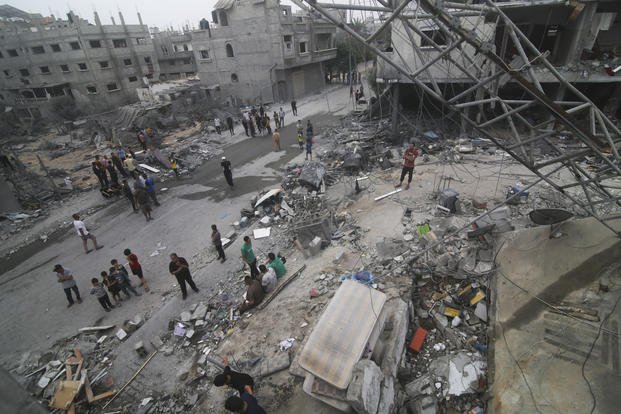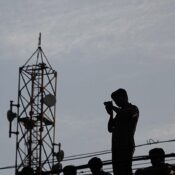
Israel’s military reports that combat operations in a portion of north Gaza are over
After days of fierce battle and more than 200 airstrikes, Israeli forces have ceased operations in the Jabalia area of north Gaza. Meanwhile, they are continuing their investigation into Rafah in south Gaza, allegedly targeting the last significant bastion of Hamas units.
According to the IDF, Israeli troops launched an attack to dismantle militant combat units they claim are holed up in the city on the Egyptian border after discovering stocks of missile launchers and other weaponry as well as Hamas tunnel shafts in the heart of Rafah on Friday.
The Israeli military stated in a statement that after more than two weeks of intense battle in Jabalia, the troops had finished their mission and were withdrawing to make way for further operations in Gaza.
Seven of the 250 hostages that Hamas-led militants kidnapped when they broke over the border into Israel on October 7 of last year and killed almost 1,200 people were found dead during the operation, according to Israeli statistics.
Since then, Israel has killed at least 36,284 Palestinians in its air and land conflict in Gaza, according to an update released by the health ministry on Friday. A large portion of the heavily populated enclave is in ruins.
A top Israeli security officer stated on Friday that Israel will not consent to any ceasefire that does not include the release of the other hostages. As long as the Israelis put an end to the conflict, Hamas had stated on Thursday that it would be prepared for a deal that included exchanging hostages for Palestinian inmates detained in Israel.
Hamas converted the “civilian area into a fortified combat compound” in Jabalia, a densely populated urban sector inhabited by refugees and their descendants from the 1948 conflict that led to the creation of Israel, according to an Israeli military statement.
It claimed that Israeli forces destroyed primed rocket launchers, took control of substantial weapon depots, and killed hundreds of militants in close quarters fighting.
According to the report, Israel forces killed the district battalion commander of Hamas and destroyed a network of weapons-filled tunnels that spanned more than 10 km underground.
Israel has attributed the high civilian casualty rate in the conflict on what it claims is Hamas’ intentional embedding of fighters in residential neighborhoods. Hamas has refuted claims that its fighters use civilians as cover.
Weeks of fierce fighting have severely damaged Jabalia, highlighting Israel’s challenges in eliminating Hamas forces.
Early in the Israeli assault, there were weeks of intense fighting in Jabalia. In January, the IDF declared that it had killed all of the Hamas commanders and destroyed the combat units of Gaza’s ruling group in the region.
With Hamas’s strong ties to Gaza’s social fabric, Israeli Prime Minister Benjamin Netanyahu’s pledge to destroy the Islamist organization as a political and military entity has met resistance.
On Wednesday, U.S. Secretary of State Antony Blinken encouraged Israel to develop a post-war strategy for Gaza, cautioning that in the absence of one, future military successes could not be sustainable and that anarchy, turmoil, and a return of Hamas could result.
A conference on Gaza Aid in Jordan
The 2.3 million people living in Gaza have become more malnourished as a result of the prolonged conflict and widespread destruction of the country’s infrastructure. The United Nations has issued a famine warning as a result of the slowing relief supplies.
In cooperation with Egypt and the UN, Jordan will organize an urgent international conference on June 11 to discuss the humanitarian response to the conflict, the royal palace of Amman announced on Friday.
As part of a series of probing operations surrounding the area that has turned into one of the primary focal points of the Gaza War, Israeli tanks thundered into Rafah’s city center on Tuesday.
While conducting “intelligence-based operational activities” in Rafah, which fringes Gaza’s border with Egypt, the army said it discovered longer-range missiles along with stores of rocket-propelled grenades, explosives, and ammunition.
For the first time in months, Hamas gunmen showed off their prowess in Rafah last week when they launched rockets at Tel Aviv, Israel’s major commercial center, on Sunday.
More than a million Palestinians forced from their homes by fighting in other parts of the small coastal enclave found sanctuary in Rafah, the only major city in Gaza still held by Israeli soldiers. However, the majority of these people have now fled after being ordered to leave ahead of the Israeli attack.
Israel has warned for weeks that it intended to mount an assault on the remaining Hamas battalions in Rafah, sparking international outrage and cautions even from friends like the United States not to destroy the city while it remained full of displaced people.
The dangers were highlighted on Sunday when at least 45 people who were taking refuge in tents close to the property the Israeli jets struck were murdered in a fire started by an airstrike directed at two Hamas commanders outside the city.
All Categories
Recent Posts
Tags
+13162306000
zoneyetu@yahoo.com



